Brand Management Report: Strategies, Equity, and Value for Coco-Cola
VerifiedAdded on 2020/06/06
|18
|4997
|72
Report
AI Summary
This report provides a comprehensive analysis of Coco-Cola's brand management, exploring its significance as a marketing tool and differentiating between product and brand. It delves into the key elements of a successful brand strategy, focusing on managing brand equity through public relations, social media, and digital marketing. The report evaluates various strategies related to portfolio management, including active and passive approaches, and assesses how Coco-Cola aims to drive revenue and growth. Furthermore, it examines techniques for measuring brand value, highlighting the challenges faced by the company, such as intense competition and evolving consumer expectations. The report underscores the importance of brand recognition, competitive advantage, and stable assets in building a strong brand image, ultimately contributing to increased market share and profitability.

BRAND-MANAGEMENT
Paraphrase This Document
Need a fresh take? Get an instant paraphrase of this document with our AI Paraphraser
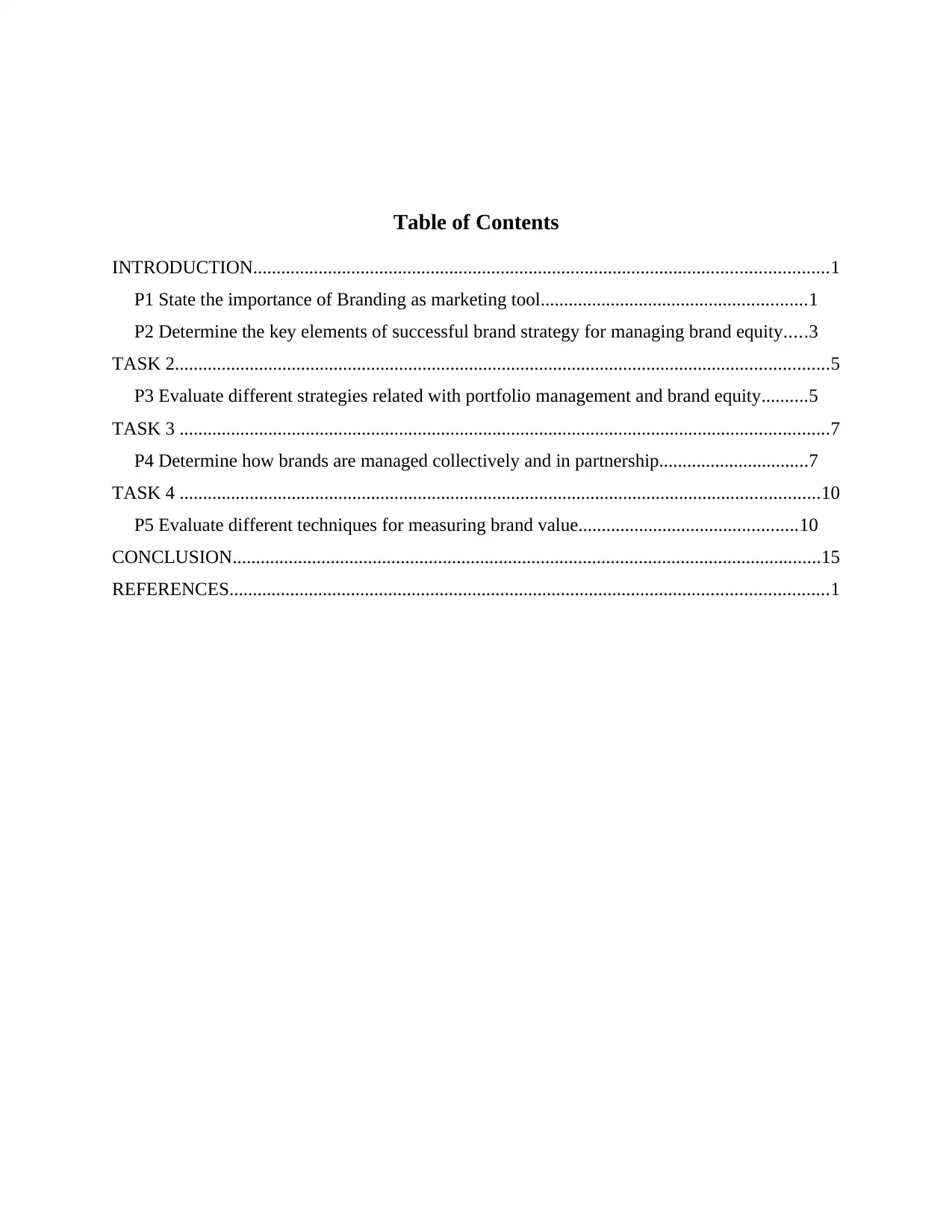
Table of Contents
INTRODUCTION...........................................................................................................................1
P1 State the importance of Branding as marketing tool.........................................................1
P2 Determine the key elements of successful brand strategy for managing brand equity.....3
TASK 2............................................................................................................................................5
P3 Evaluate different strategies related with portfolio management and brand equity..........5
TASK 3 ...........................................................................................................................................7
P4 Determine how brands are managed collectively and in partnership................................7
TASK 4 .........................................................................................................................................10
P5 Evaluate different techniques for measuring brand value...............................................10
CONCLUSION..............................................................................................................................15
REFERENCES................................................................................................................................1
INTRODUCTION...........................................................................................................................1
P1 State the importance of Branding as marketing tool.........................................................1
P2 Determine the key elements of successful brand strategy for managing brand equity.....3
TASK 2............................................................................................................................................5
P3 Evaluate different strategies related with portfolio management and brand equity..........5
TASK 3 ...........................................................................................................................................7
P4 Determine how brands are managed collectively and in partnership................................7
TASK 4 .........................................................................................................................................10
P5 Evaluate different techniques for measuring brand value...............................................10
CONCLUSION..............................................................................................................................15
REFERENCES................................................................................................................................1
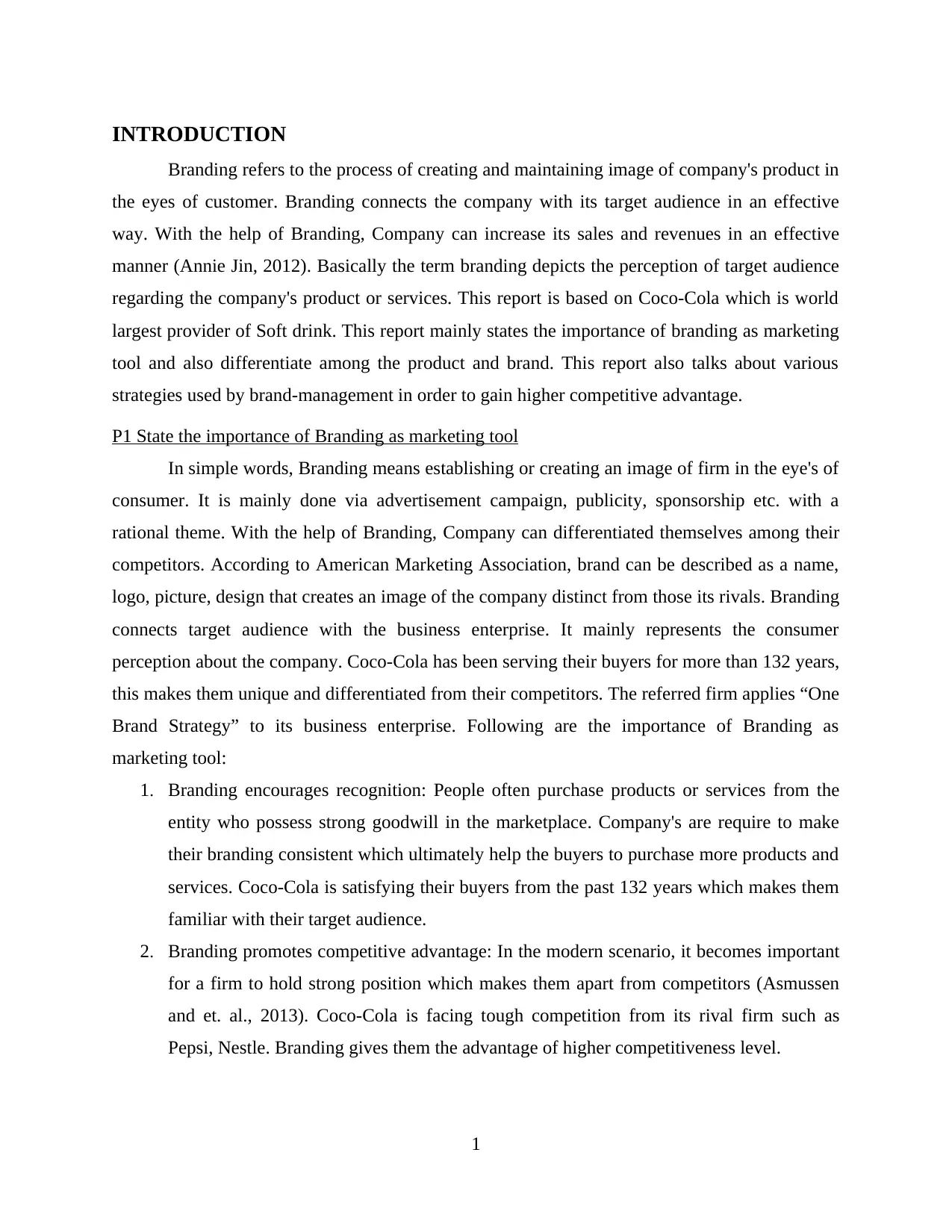
INTRODUCTION
Branding refers to the process of creating and maintaining image of company's product in
the eyes of customer. Branding connects the company with its target audience in an effective
way. With the help of Branding, Company can increase its sales and revenues in an effective
manner (Annie Jin, 2012). Basically the term branding depicts the perception of target audience
regarding the company's product or services. This report is based on Coco-Cola which is world
largest provider of Soft drink. This report mainly states the importance of branding as marketing
tool and also differentiate among the product and brand. This report also talks about various
strategies used by brand-management in order to gain higher competitive advantage.
P1 State the importance of Branding as marketing tool
In simple words, Branding means establishing or creating an image of firm in the eye's of
consumer. It is mainly done via advertisement campaign, publicity, sponsorship etc. with a
rational theme. With the help of Branding, Company can differentiated themselves among their
competitors. According to American Marketing Association, brand can be described as a name,
logo, picture, design that creates an image of the company distinct from those its rivals. Branding
connects target audience with the business enterprise. It mainly represents the consumer
perception about the company. Coco-Cola has been serving their buyers for more than 132 years,
this makes them unique and differentiated from their competitors. The referred firm applies “One
Brand Strategy” to its business enterprise. Following are the importance of Branding as
marketing tool:
1. Branding encourages recognition: People often purchase products or services from the
entity who possess strong goodwill in the marketplace. Company's are require to make
their branding consistent which ultimately help the buyers to purchase more products and
services. Coco-Cola is satisfying their buyers from the past 132 years which makes them
familiar with their target audience.
2. Branding promotes competitive advantage: In the modern scenario, it becomes important
for a firm to hold strong position which makes them apart from competitors (Asmussen
and et. al., 2013). Coco-Cola is facing tough competition from its rival firm such as
Pepsi, Nestle. Branding gives them the advantage of higher competitiveness level.
1
Branding refers to the process of creating and maintaining image of company's product in
the eyes of customer. Branding connects the company with its target audience in an effective
way. With the help of Branding, Company can increase its sales and revenues in an effective
manner (Annie Jin, 2012). Basically the term branding depicts the perception of target audience
regarding the company's product or services. This report is based on Coco-Cola which is world
largest provider of Soft drink. This report mainly states the importance of branding as marketing
tool and also differentiate among the product and brand. This report also talks about various
strategies used by brand-management in order to gain higher competitive advantage.
P1 State the importance of Branding as marketing tool
In simple words, Branding means establishing or creating an image of firm in the eye's of
consumer. It is mainly done via advertisement campaign, publicity, sponsorship etc. with a
rational theme. With the help of Branding, Company can differentiated themselves among their
competitors. According to American Marketing Association, brand can be described as a name,
logo, picture, design that creates an image of the company distinct from those its rivals. Branding
connects target audience with the business enterprise. It mainly represents the consumer
perception about the company. Coco-Cola has been serving their buyers for more than 132 years,
this makes them unique and differentiated from their competitors. The referred firm applies “One
Brand Strategy” to its business enterprise. Following are the importance of Branding as
marketing tool:
1. Branding encourages recognition: People often purchase products or services from the
entity who possess strong goodwill in the marketplace. Company's are require to make
their branding consistent which ultimately help the buyers to purchase more products and
services. Coco-Cola is satisfying their buyers from the past 132 years which makes them
familiar with their target audience.
2. Branding promotes competitive advantage: In the modern scenario, it becomes important
for a firm to hold strong position which makes them apart from competitors (Asmussen
and et. al., 2013). Coco-Cola is facing tough competition from its rival firm such as
Pepsi, Nestle. Branding gives them the advantage of higher competitiveness level.
1
⊘ This is a preview!⊘
Do you want full access?
Subscribe today to unlock all pages.

Trusted by 1+ million students worldwide
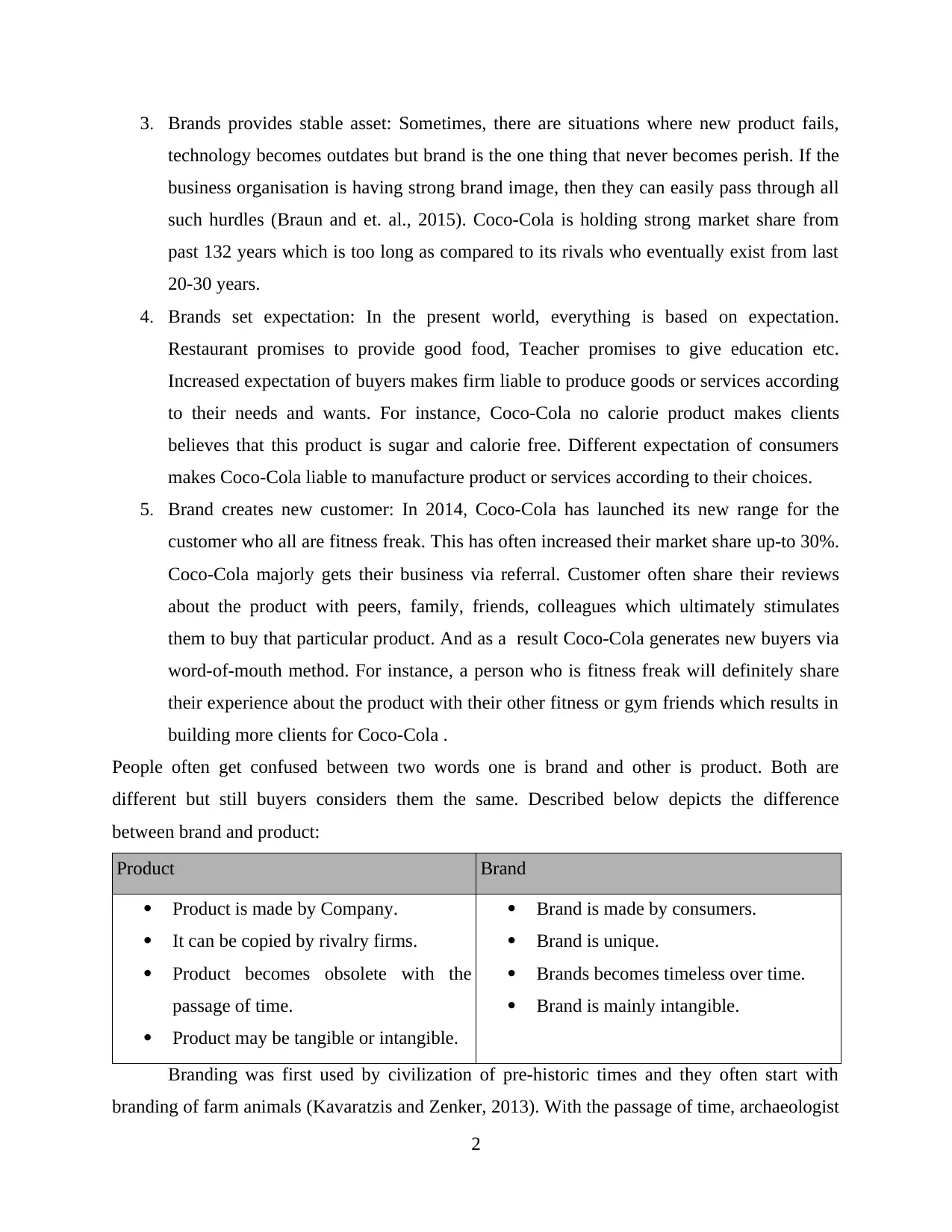
3. Brands provides stable asset: Sometimes, there are situations where new product fails,
technology becomes outdates but brand is the one thing that never becomes perish. If the
business organisation is having strong brand image, then they can easily pass through all
such hurdles (Braun and et. al., 2015). Coco-Cola is holding strong market share from
past 132 years which is too long as compared to its rivals who eventually exist from last
20-30 years.
4. Brands set expectation: In the present world, everything is based on expectation.
Restaurant promises to provide good food, Teacher promises to give education etc.
Increased expectation of buyers makes firm liable to produce goods or services according
to their needs and wants. For instance, Coco-Cola no calorie product makes clients
believes that this product is sugar and calorie free. Different expectation of consumers
makes Coco-Cola liable to manufacture product or services according to their choices.
5. Brand creates new customer: In 2014, Coco-Cola has launched its new range for the
customer who all are fitness freak. This has often increased their market share up-to 30%.
Coco-Cola majorly gets their business via referral. Customer often share their reviews
about the product with peers, family, friends, colleagues which ultimately stimulates
them to buy that particular product. And as a result Coco-Cola generates new buyers via
word-of-mouth method. For instance, a person who is fitness freak will definitely share
their experience about the product with their other fitness or gym friends which results in
building more clients for Coco-Cola .
People often get confused between two words one is brand and other is product. Both are
different but still buyers considers them the same. Described below depicts the difference
between brand and product:
Product Brand
Product is made by Company.
It can be copied by rivalry firms.
Product becomes obsolete with the
passage of time.
Product may be tangible or intangible.
Brand is made by consumers.
Brand is unique.
Brands becomes timeless over time.
Brand is mainly intangible.
Branding was first used by civilization of pre-historic times and they often start with
branding of farm animals (Kavaratzis and Zenker, 2013). With the passage of time, archaeologist
2
technology becomes outdates but brand is the one thing that never becomes perish. If the
business organisation is having strong brand image, then they can easily pass through all
such hurdles (Braun and et. al., 2015). Coco-Cola is holding strong market share from
past 132 years which is too long as compared to its rivals who eventually exist from last
20-30 years.
4. Brands set expectation: In the present world, everything is based on expectation.
Restaurant promises to provide good food, Teacher promises to give education etc.
Increased expectation of buyers makes firm liable to produce goods or services according
to their needs and wants. For instance, Coco-Cola no calorie product makes clients
believes that this product is sugar and calorie free. Different expectation of consumers
makes Coco-Cola liable to manufacture product or services according to their choices.
5. Brand creates new customer: In 2014, Coco-Cola has launched its new range for the
customer who all are fitness freak. This has often increased their market share up-to 30%.
Coco-Cola majorly gets their business via referral. Customer often share their reviews
about the product with peers, family, friends, colleagues which ultimately stimulates
them to buy that particular product. And as a result Coco-Cola generates new buyers via
word-of-mouth method. For instance, a person who is fitness freak will definitely share
their experience about the product with their other fitness or gym friends which results in
building more clients for Coco-Cola .
People often get confused between two words one is brand and other is product. Both are
different but still buyers considers them the same. Described below depicts the difference
between brand and product:
Product Brand
Product is made by Company.
It can be copied by rivalry firms.
Product becomes obsolete with the
passage of time.
Product may be tangible or intangible.
Brand is made by consumers.
Brand is unique.
Brands becomes timeless over time.
Brand is mainly intangible.
Branding was first used by civilization of pre-historic times and they often start with
branding of farm animals (Kavaratzis and Zenker, 2013). With the passage of time, archaeologist
2
Paraphrase This Document
Need a fresh take? Get an instant paraphrase of this document with our AI Paraphraser
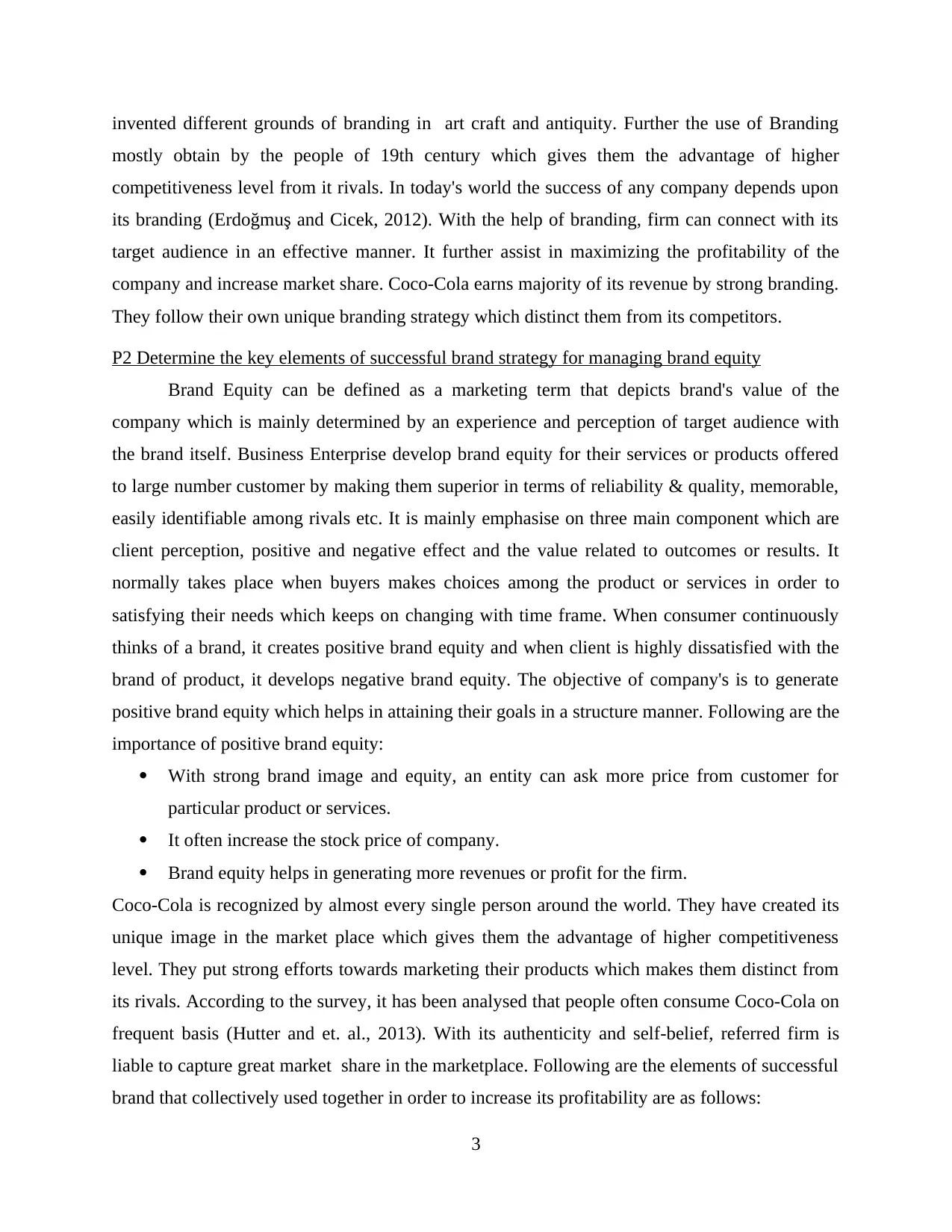
invented different grounds of branding in art craft and antiquity. Further the use of Branding
mostly obtain by the people of 19th century which gives them the advantage of higher
competitiveness level from it rivals. In today's world the success of any company depends upon
its branding (Erdoğmuş and Cicek, 2012). With the help of branding, firm can connect with its
target audience in an effective manner. It further assist in maximizing the profitability of the
company and increase market share. Coco-Cola earns majority of its revenue by strong branding.
They follow their own unique branding strategy which distinct them from its competitors.
P2 Determine the key elements of successful brand strategy for managing brand equity
Brand Equity can be defined as a marketing term that depicts brand's value of the
company which is mainly determined by an experience and perception of target audience with
the brand itself. Business Enterprise develop brand equity for their services or products offered
to large number customer by making them superior in terms of reliability & quality, memorable,
easily identifiable among rivals etc. It is mainly emphasise on three main component which are
client perception, positive and negative effect and the value related to outcomes or results. It
normally takes place when buyers makes choices among the product or services in order to
satisfying their needs which keeps on changing with time frame. When consumer continuously
thinks of a brand, it creates positive brand equity and when client is highly dissatisfied with the
brand of product, it develops negative brand equity. The objective of company's is to generate
positive brand equity which helps in attaining their goals in a structure manner. Following are the
importance of positive brand equity:
With strong brand image and equity, an entity can ask more price from customer for
particular product or services.
It often increase the stock price of company.
Brand equity helps in generating more revenues or profit for the firm.
Coco-Cola is recognized by almost every single person around the world. They have created its
unique image in the market place which gives them the advantage of higher competitiveness
level. They put strong efforts towards marketing their products which makes them distinct from
its rivals. According to the survey, it has been analysed that people often consume Coco-Cola on
frequent basis (Hutter and et. al., 2013). With its authenticity and self-belief, referred firm is
liable to capture great market share in the marketplace. Following are the elements of successful
brand that collectively used together in order to increase its profitability are as follows:
3
mostly obtain by the people of 19th century which gives them the advantage of higher
competitiveness level from it rivals. In today's world the success of any company depends upon
its branding (Erdoğmuş and Cicek, 2012). With the help of branding, firm can connect with its
target audience in an effective manner. It further assist in maximizing the profitability of the
company and increase market share. Coco-Cola earns majority of its revenue by strong branding.
They follow their own unique branding strategy which distinct them from its competitors.
P2 Determine the key elements of successful brand strategy for managing brand equity
Brand Equity can be defined as a marketing term that depicts brand's value of the
company which is mainly determined by an experience and perception of target audience with
the brand itself. Business Enterprise develop brand equity for their services or products offered
to large number customer by making them superior in terms of reliability & quality, memorable,
easily identifiable among rivals etc. It is mainly emphasise on three main component which are
client perception, positive and negative effect and the value related to outcomes or results. It
normally takes place when buyers makes choices among the product or services in order to
satisfying their needs which keeps on changing with time frame. When consumer continuously
thinks of a brand, it creates positive brand equity and when client is highly dissatisfied with the
brand of product, it develops negative brand equity. The objective of company's is to generate
positive brand equity which helps in attaining their goals in a structure manner. Following are the
importance of positive brand equity:
With strong brand image and equity, an entity can ask more price from customer for
particular product or services.
It often increase the stock price of company.
Brand equity helps in generating more revenues or profit for the firm.
Coco-Cola is recognized by almost every single person around the world. They have created its
unique image in the market place which gives them the advantage of higher competitiveness
level. They put strong efforts towards marketing their products which makes them distinct from
its rivals. According to the survey, it has been analysed that people often consume Coco-Cola on
frequent basis (Hutter and et. al., 2013). With its authenticity and self-belief, referred firm is
liable to capture great market share in the marketplace. Following are the elements of successful
brand that collectively used together in order to increase its profitability are as follows:
3
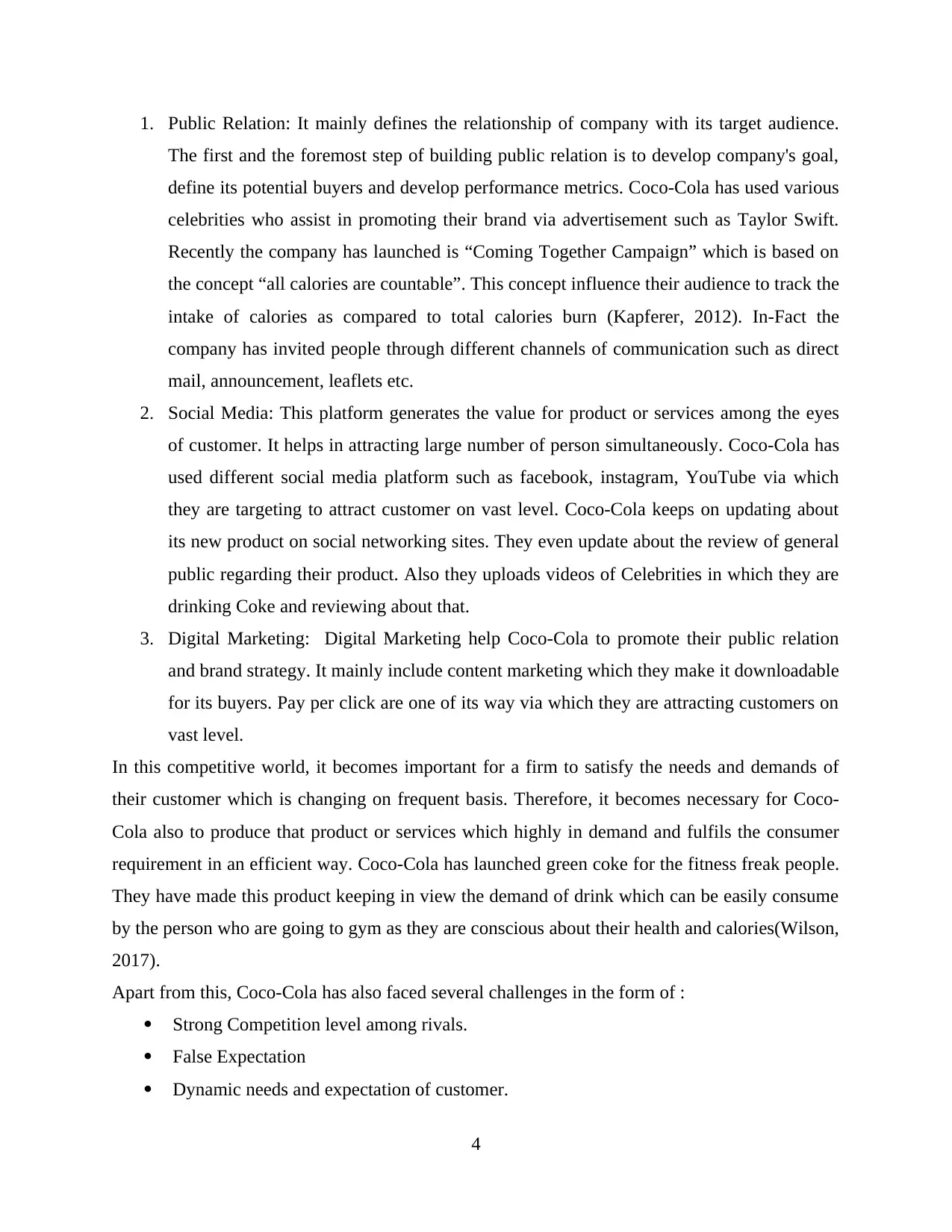
1. Public Relation: It mainly defines the relationship of company with its target audience.
The first and the foremost step of building public relation is to develop company's goal,
define its potential buyers and develop performance metrics. Coco-Cola has used various
celebrities who assist in promoting their brand via advertisement such as Taylor Swift.
Recently the company has launched is “Coming Together Campaign” which is based on
the concept “all calories are countable”. This concept influence their audience to track the
intake of calories as compared to total calories burn (Kapferer, 2012). In-Fact the
company has invited people through different channels of communication such as direct
mail, announcement, leaflets etc.
2. Social Media: This platform generates the value for product or services among the eyes
of customer. It helps in attracting large number of person simultaneously. Coco-Cola has
used different social media platform such as facebook, instagram, YouTube via which
they are targeting to attract customer on vast level. Coco-Cola keeps on updating about
its new product on social networking sites. They even update about the review of general
public regarding their product. Also they uploads videos of Celebrities in which they are
drinking Coke and reviewing about that.
3. Digital Marketing: Digital Marketing help Coco-Cola to promote their public relation
and brand strategy. It mainly include content marketing which they make it downloadable
for its buyers. Pay per click are one of its way via which they are attracting customers on
vast level.
In this competitive world, it becomes important for a firm to satisfy the needs and demands of
their customer which is changing on frequent basis. Therefore, it becomes necessary for Coco-
Cola also to produce that product or services which highly in demand and fulfils the consumer
requirement in an efficient way. Coco-Cola has launched green coke for the fitness freak people.
They have made this product keeping in view the demand of drink which can be easily consume
by the person who are going to gym as they are conscious about their health and calories(Wilson,
2017).
Apart from this, Coco-Cola has also faced several challenges in the form of :
Strong Competition level among rivals.
False Expectation
Dynamic needs and expectation of customer.
4
The first and the foremost step of building public relation is to develop company's goal,
define its potential buyers and develop performance metrics. Coco-Cola has used various
celebrities who assist in promoting their brand via advertisement such as Taylor Swift.
Recently the company has launched is “Coming Together Campaign” which is based on
the concept “all calories are countable”. This concept influence their audience to track the
intake of calories as compared to total calories burn (Kapferer, 2012). In-Fact the
company has invited people through different channels of communication such as direct
mail, announcement, leaflets etc.
2. Social Media: This platform generates the value for product or services among the eyes
of customer. It helps in attracting large number of person simultaneously. Coco-Cola has
used different social media platform such as facebook, instagram, YouTube via which
they are targeting to attract customer on vast level. Coco-Cola keeps on updating about
its new product on social networking sites. They even update about the review of general
public regarding their product. Also they uploads videos of Celebrities in which they are
drinking Coke and reviewing about that.
3. Digital Marketing: Digital Marketing help Coco-Cola to promote their public relation
and brand strategy. It mainly include content marketing which they make it downloadable
for its buyers. Pay per click are one of its way via which they are attracting customers on
vast level.
In this competitive world, it becomes important for a firm to satisfy the needs and demands of
their customer which is changing on frequent basis. Therefore, it becomes necessary for Coco-
Cola also to produce that product or services which highly in demand and fulfils the consumer
requirement in an efficient way. Coco-Cola has launched green coke for the fitness freak people.
They have made this product keeping in view the demand of drink which can be easily consume
by the person who are going to gym as they are conscious about their health and calories(Wilson,
2017).
Apart from this, Coco-Cola has also faced several challenges in the form of :
Strong Competition level among rivals.
False Expectation
Dynamic needs and expectation of customer.
4
⊘ This is a preview!⊘
Do you want full access?
Subscribe today to unlock all pages.

Trusted by 1+ million students worldwide
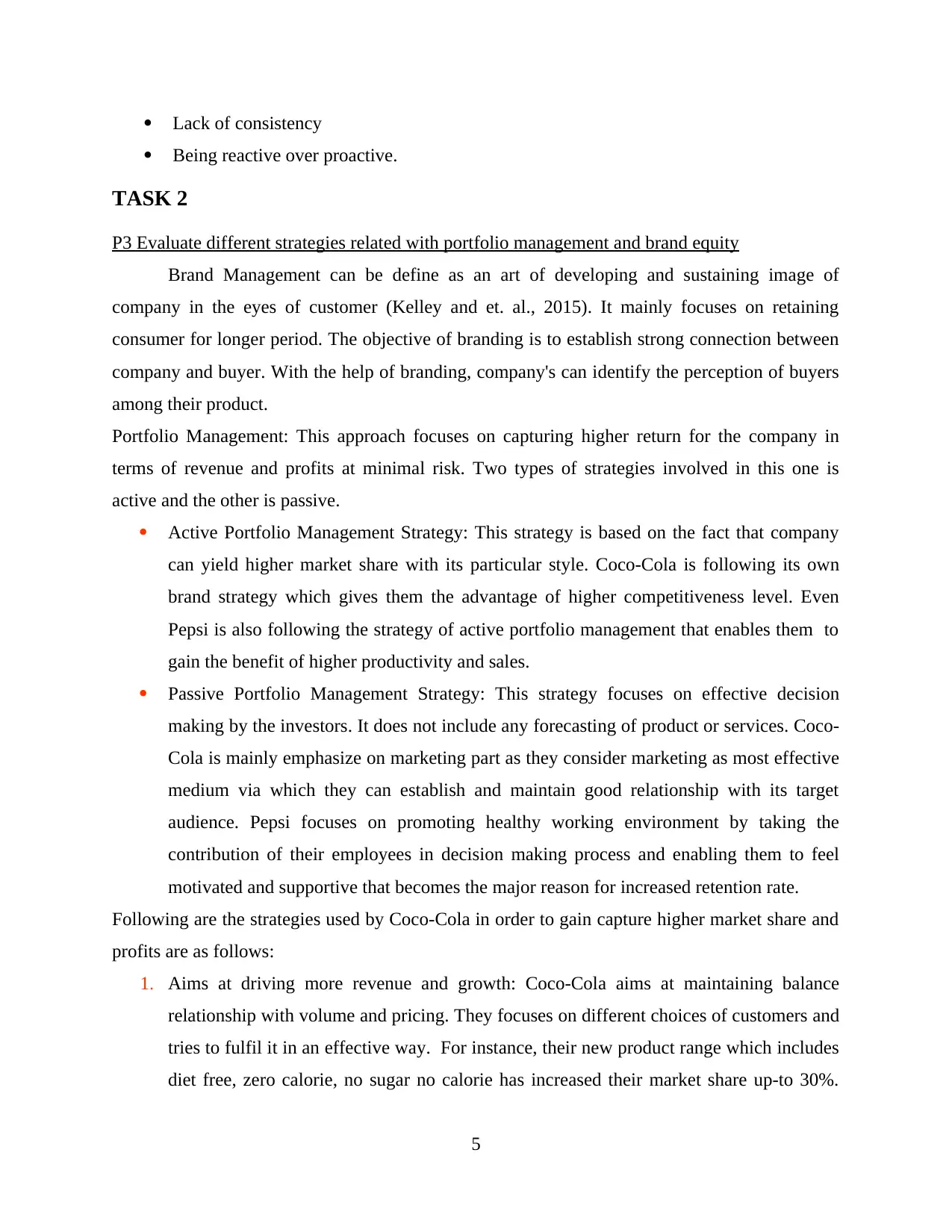
Lack of consistency
Being reactive over proactive.
TASK 2
P3 Evaluate different strategies related with portfolio management and brand equity
Brand Management can be define as an art of developing and sustaining image of
company in the eyes of customer (Kelley and et. al., 2015). It mainly focuses on retaining
consumer for longer period. The objective of branding is to establish strong connection between
company and buyer. With the help of branding, company's can identify the perception of buyers
among their product.
Portfolio Management: This approach focuses on capturing higher return for the company in
terms of revenue and profits at minimal risk. Two types of strategies involved in this one is
active and the other is passive.
Active Portfolio Management Strategy: This strategy is based on the fact that company
can yield higher market share with its particular style. Coco-Cola is following its own
brand strategy which gives them the advantage of higher competitiveness level. Even
Pepsi is also following the strategy of active portfolio management that enables them to
gain the benefit of higher productivity and sales.
Passive Portfolio Management Strategy: This strategy focuses on effective decision
making by the investors. It does not include any forecasting of product or services. Coco-
Cola is mainly emphasize on marketing part as they consider marketing as most effective
medium via which they can establish and maintain good relationship with its target
audience. Pepsi focuses on promoting healthy working environment by taking the
contribution of their employees in decision making process and enabling them to feel
motivated and supportive that becomes the major reason for increased retention rate.
Following are the strategies used by Coco-Cola in order to gain capture higher market share and
profits are as follows:
1. Aims at driving more revenue and growth: Coco-Cola aims at maintaining balance
relationship with volume and pricing. They focuses on different choices of customers and
tries to fulfil it in an effective way. For instance, their new product range which includes
diet free, zero calorie, no sugar no calorie has increased their market share up-to 30%.
5
Being reactive over proactive.
TASK 2
P3 Evaluate different strategies related with portfolio management and brand equity
Brand Management can be define as an art of developing and sustaining image of
company in the eyes of customer (Kelley and et. al., 2015). It mainly focuses on retaining
consumer for longer period. The objective of branding is to establish strong connection between
company and buyer. With the help of branding, company's can identify the perception of buyers
among their product.
Portfolio Management: This approach focuses on capturing higher return for the company in
terms of revenue and profits at minimal risk. Two types of strategies involved in this one is
active and the other is passive.
Active Portfolio Management Strategy: This strategy is based on the fact that company
can yield higher market share with its particular style. Coco-Cola is following its own
brand strategy which gives them the advantage of higher competitiveness level. Even
Pepsi is also following the strategy of active portfolio management that enables them to
gain the benefit of higher productivity and sales.
Passive Portfolio Management Strategy: This strategy focuses on effective decision
making by the investors. It does not include any forecasting of product or services. Coco-
Cola is mainly emphasize on marketing part as they consider marketing as most effective
medium via which they can establish and maintain good relationship with its target
audience. Pepsi focuses on promoting healthy working environment by taking the
contribution of their employees in decision making process and enabling them to feel
motivated and supportive that becomes the major reason for increased retention rate.
Following are the strategies used by Coco-Cola in order to gain capture higher market share and
profits are as follows:
1. Aims at driving more revenue and growth: Coco-Cola aims at maintaining balance
relationship with volume and pricing. They focuses on different choices of customers and
tries to fulfil it in an effective way. For instance, their new product range which includes
diet free, zero calorie, no sugar no calorie has increased their market share up-to 30%.
5
Paraphrase This Document
Need a fresh take? Get an instant paraphrase of this document with our AI Paraphraser
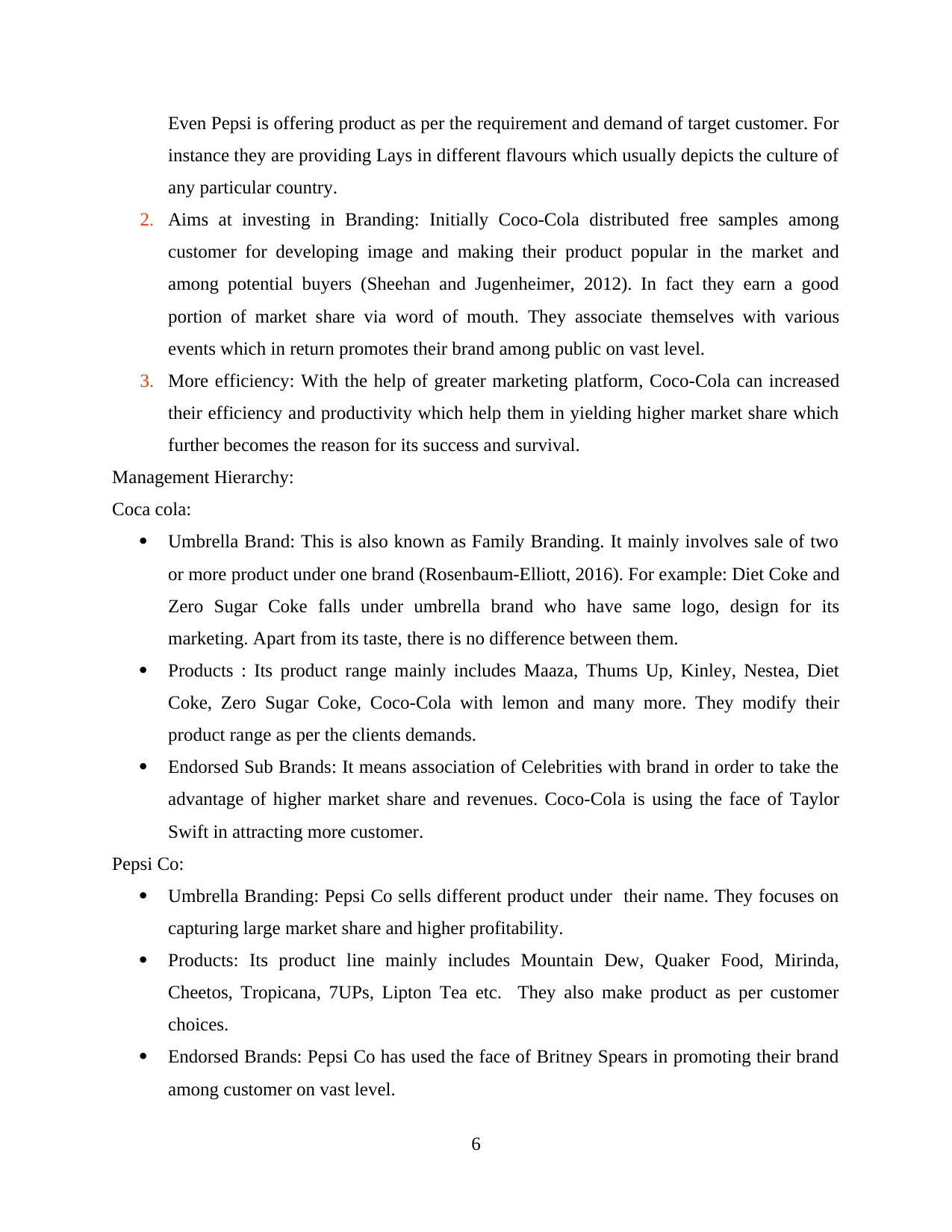
Even Pepsi is offering product as per the requirement and demand of target customer. For
instance they are providing Lays in different flavours which usually depicts the culture of
any particular country.
2. Aims at investing in Branding: Initially Coco-Cola distributed free samples among
customer for developing image and making their product popular in the market and
among potential buyers (Sheehan and Jugenheimer, 2012). In fact they earn a good
portion of market share via word of mouth. They associate themselves with various
events which in return promotes their brand among public on vast level.
3. More efficiency: With the help of greater marketing platform, Coco-Cola can increased
their efficiency and productivity which help them in yielding higher market share which
further becomes the reason for its success and survival.
Management Hierarchy:
Coca cola:
Umbrella Brand: This is also known as Family Branding. It mainly involves sale of two
or more product under one brand (Rosenbaum-Elliott, 2016). For example: Diet Coke and
Zero Sugar Coke falls under umbrella brand who have same logo, design for its
marketing. Apart from its taste, there is no difference between them.
Products : Its product range mainly includes Maaza, Thums Up, Kinley, Nestea, Diet
Coke, Zero Sugar Coke, Coco-Cola with lemon and many more. They modify their
product range as per the clients demands.
Endorsed Sub Brands: It means association of Celebrities with brand in order to take the
advantage of higher market share and revenues. Coco-Cola is using the face of Taylor
Swift in attracting more customer.
Pepsi Co:
Umbrella Branding: Pepsi Co sells different product under their name. They focuses on
capturing large market share and higher profitability.
Products: Its product line mainly includes Mountain Dew, Quaker Food, Mirinda,
Cheetos, Tropicana, 7UPs, Lipton Tea etc. They also make product as per customer
choices.
Endorsed Brands: Pepsi Co has used the face of Britney Spears in promoting their brand
among customer on vast level.
6
instance they are providing Lays in different flavours which usually depicts the culture of
any particular country.
2. Aims at investing in Branding: Initially Coco-Cola distributed free samples among
customer for developing image and making their product popular in the market and
among potential buyers (Sheehan and Jugenheimer, 2012). In fact they earn a good
portion of market share via word of mouth. They associate themselves with various
events which in return promotes their brand among public on vast level.
3. More efficiency: With the help of greater marketing platform, Coco-Cola can increased
their efficiency and productivity which help them in yielding higher market share which
further becomes the reason for its success and survival.
Management Hierarchy:
Coca cola:
Umbrella Brand: This is also known as Family Branding. It mainly involves sale of two
or more product under one brand (Rosenbaum-Elliott, 2016). For example: Diet Coke and
Zero Sugar Coke falls under umbrella brand who have same logo, design for its
marketing. Apart from its taste, there is no difference between them.
Products : Its product range mainly includes Maaza, Thums Up, Kinley, Nestea, Diet
Coke, Zero Sugar Coke, Coco-Cola with lemon and many more. They modify their
product range as per the clients demands.
Endorsed Sub Brands: It means association of Celebrities with brand in order to take the
advantage of higher market share and revenues. Coco-Cola is using the face of Taylor
Swift in attracting more customer.
Pepsi Co:
Umbrella Branding: Pepsi Co sells different product under their name. They focuses on
capturing large market share and higher profitability.
Products: Its product line mainly includes Mountain Dew, Quaker Food, Mirinda,
Cheetos, Tropicana, 7UPs, Lipton Tea etc. They also make product as per customer
choices.
Endorsed Brands: Pepsi Co has used the face of Britney Spears in promoting their brand
among customer on vast level.
6
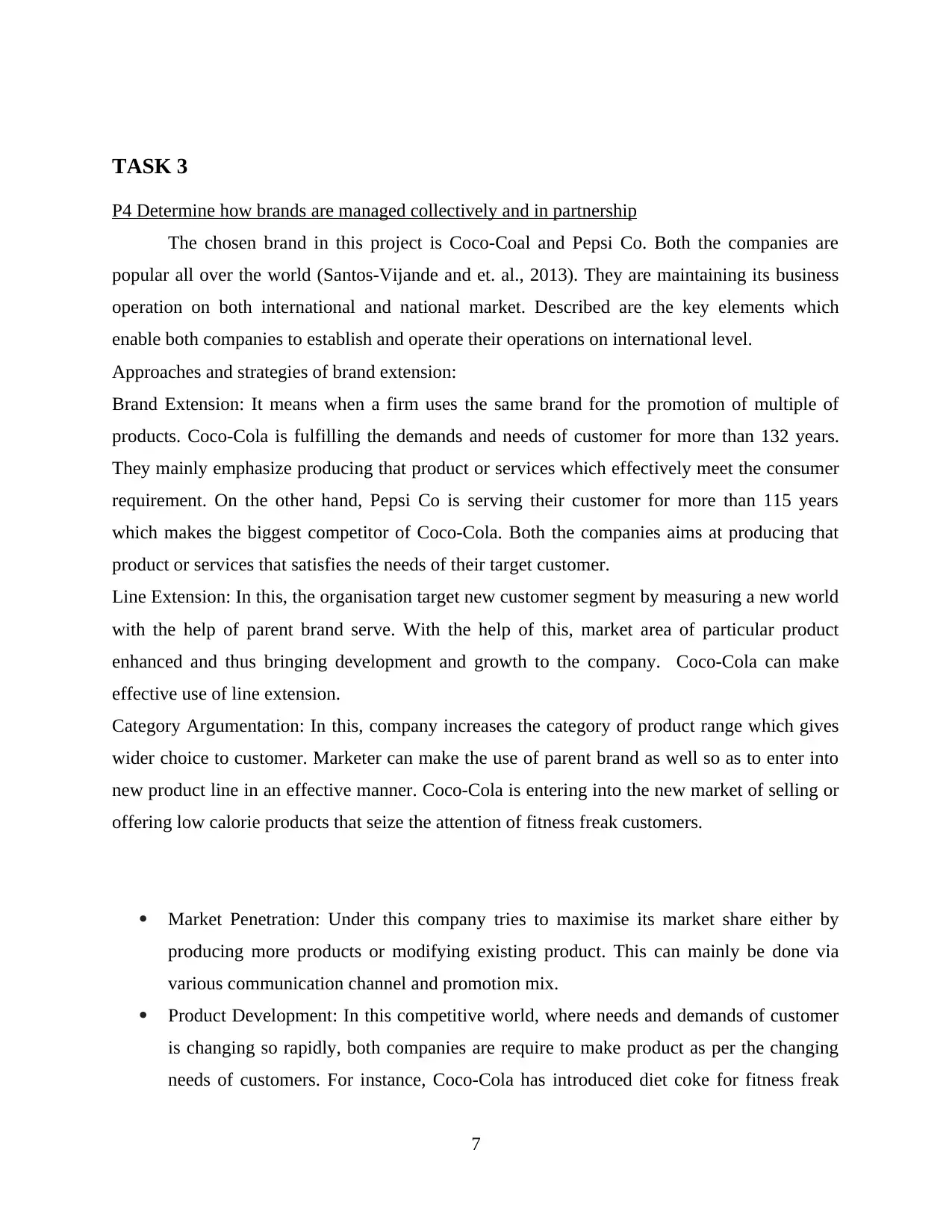
TASK 3
P4 Determine how brands are managed collectively and in partnership
The chosen brand in this project is Coco-Coal and Pepsi Co. Both the companies are
popular all over the world (Santos-Vijande and et. al., 2013). They are maintaining its business
operation on both international and national market. Described are the key elements which
enable both companies to establish and operate their operations on international level.
Approaches and strategies of brand extension:
Brand Extension: It means when a firm uses the same brand for the promotion of multiple of
products. Coco-Cola is fulfilling the demands and needs of customer for more than 132 years.
They mainly emphasize producing that product or services which effectively meet the consumer
requirement. On the other hand, Pepsi Co is serving their customer for more than 115 years
which makes the biggest competitor of Coco-Cola. Both the companies aims at producing that
product or services that satisfies the needs of their target customer.
Line Extension: In this, the organisation target new customer segment by measuring a new world
with the help of parent brand serve. With the help of this, market area of particular product
enhanced and thus bringing development and growth to the company. Coco-Cola can make
effective use of line extension.
Category Argumentation: In this, company increases the category of product range which gives
wider choice to customer. Marketer can make the use of parent brand as well so as to enter into
new product line in an effective manner. Coco-Cola is entering into the new market of selling or
offering low calorie products that seize the attention of fitness freak customers.
Market Penetration: Under this company tries to maximise its market share either by
producing more products or modifying existing product. This can mainly be done via
various communication channel and promotion mix.
Product Development: In this competitive world, where needs and demands of customer
is changing so rapidly, both companies are require to make product as per the changing
needs of customers. For instance, Coco-Cola has introduced diet coke for fitness freak
7
P4 Determine how brands are managed collectively and in partnership
The chosen brand in this project is Coco-Coal and Pepsi Co. Both the companies are
popular all over the world (Santos-Vijande and et. al., 2013). They are maintaining its business
operation on both international and national market. Described are the key elements which
enable both companies to establish and operate their operations on international level.
Approaches and strategies of brand extension:
Brand Extension: It means when a firm uses the same brand for the promotion of multiple of
products. Coco-Cola is fulfilling the demands and needs of customer for more than 132 years.
They mainly emphasize producing that product or services which effectively meet the consumer
requirement. On the other hand, Pepsi Co is serving their customer for more than 115 years
which makes the biggest competitor of Coco-Cola. Both the companies aims at producing that
product or services that satisfies the needs of their target customer.
Line Extension: In this, the organisation target new customer segment by measuring a new world
with the help of parent brand serve. With the help of this, market area of particular product
enhanced and thus bringing development and growth to the company. Coco-Cola can make
effective use of line extension.
Category Argumentation: In this, company increases the category of product range which gives
wider choice to customer. Marketer can make the use of parent brand as well so as to enter into
new product line in an effective manner. Coco-Cola is entering into the new market of selling or
offering low calorie products that seize the attention of fitness freak customers.
Market Penetration: Under this company tries to maximise its market share either by
producing more products or modifying existing product. This can mainly be done via
various communication channel and promotion mix.
Product Development: In this competitive world, where needs and demands of customer
is changing so rapidly, both companies are require to make product as per the changing
needs of customers. For instance, Coco-Cola has introduced diet coke for fitness freak
7
⊘ This is a preview!⊘
Do you want full access?
Subscribe today to unlock all pages.

Trusted by 1+ million students worldwide
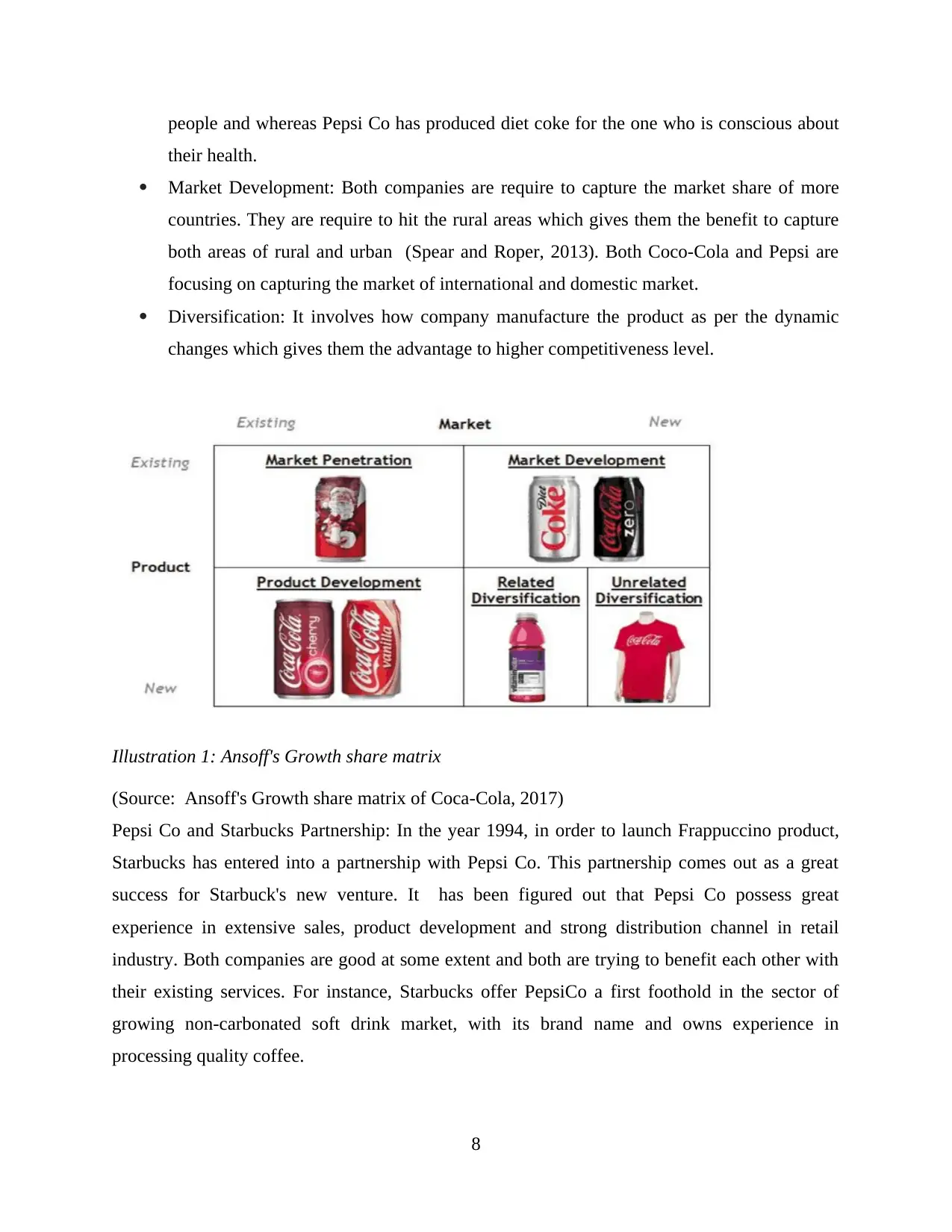
people and whereas Pepsi Co has produced diet coke for the one who is conscious about
their health.
Market Development: Both companies are require to capture the market share of more
countries. They are require to hit the rural areas which gives them the benefit to capture
both areas of rural and urban (Spear and Roper, 2013). Both Coco-Cola and Pepsi are
focusing on capturing the market of international and domestic market.
Diversification: It involves how company manufacture the product as per the dynamic
changes which gives them the advantage to higher competitiveness level.
Illustration 1: Ansoff's Growth share matrix
(Source: Ansoff's Growth share matrix of Coca-Cola, 2017)
Pepsi Co and Starbucks Partnership: In the year 1994, in order to launch Frappuccino product,
Starbucks has entered into a partnership with Pepsi Co. This partnership comes out as a great
success for Starbuck's new venture. It has been figured out that Pepsi Co possess great
experience in extensive sales, product development and strong distribution channel in retail
industry. Both companies are good at some extent and both are trying to benefit each other with
their existing services. For instance, Starbucks offer PepsiCo a first foothold in the sector of
growing non-carbonated soft drink market, with its brand name and owns experience in
processing quality coffee.
8
their health.
Market Development: Both companies are require to capture the market share of more
countries. They are require to hit the rural areas which gives them the benefit to capture
both areas of rural and urban (Spear and Roper, 2013). Both Coco-Cola and Pepsi are
focusing on capturing the market of international and domestic market.
Diversification: It involves how company manufacture the product as per the dynamic
changes which gives them the advantage to higher competitiveness level.
Illustration 1: Ansoff's Growth share matrix
(Source: Ansoff's Growth share matrix of Coca-Cola, 2017)
Pepsi Co and Starbucks Partnership: In the year 1994, in order to launch Frappuccino product,
Starbucks has entered into a partnership with Pepsi Co. This partnership comes out as a great
success for Starbuck's new venture. It has been figured out that Pepsi Co possess great
experience in extensive sales, product development and strong distribution channel in retail
industry. Both companies are good at some extent and both are trying to benefit each other with
their existing services. For instance, Starbucks offer PepsiCo a first foothold in the sector of
growing non-carbonated soft drink market, with its brand name and owns experience in
processing quality coffee.
8
Paraphrase This Document
Need a fresh take? Get an instant paraphrase of this document with our AI Paraphraser
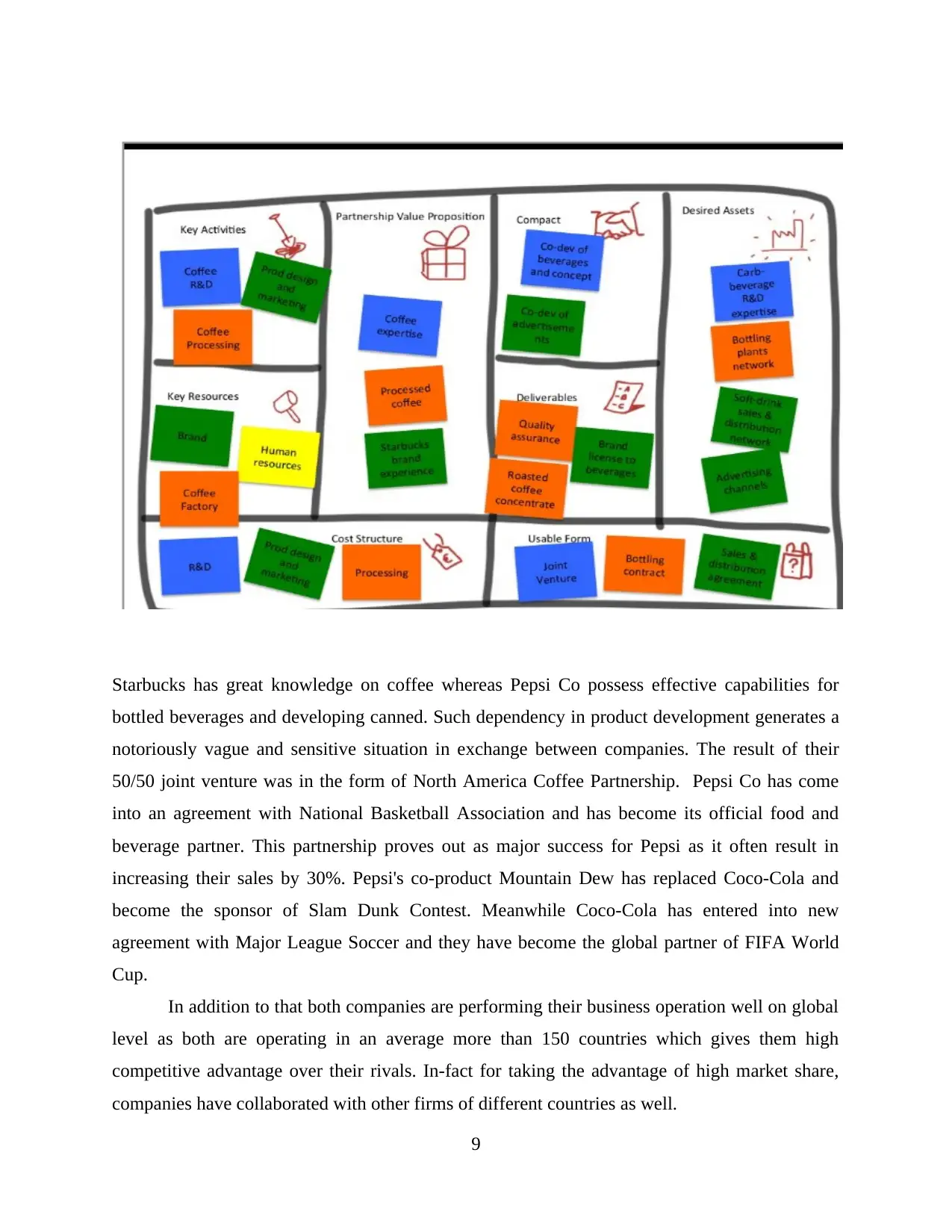
Starbucks has great knowledge on coffee whereas Pepsi Co possess effective capabilities for
bottled beverages and developing canned. Such dependency in product development generates a
notoriously vague and sensitive situation in exchange between companies. The result of their
50/50 joint venture was in the form of North America Coffee Partnership. Pepsi Co has come
into an agreement with National Basketball Association and has become its official food and
beverage partner. This partnership proves out as major success for Pepsi as it often result in
increasing their sales by 30%. Pepsi's co-product Mountain Dew has replaced Coco-Cola and
become the sponsor of Slam Dunk Contest. Meanwhile Coco-Cola has entered into new
agreement with Major League Soccer and they have become the global partner of FIFA World
Cup.
In addition to that both companies are performing their business operation well on global
level as both are operating in an average more than 150 countries which gives them high
competitive advantage over their rivals. In-fact for taking the advantage of high market share,
companies have collaborated with other firms of different countries as well.
9
bottled beverages and developing canned. Such dependency in product development generates a
notoriously vague and sensitive situation in exchange between companies. The result of their
50/50 joint venture was in the form of North America Coffee Partnership. Pepsi Co has come
into an agreement with National Basketball Association and has become its official food and
beverage partner. This partnership proves out as major success for Pepsi as it often result in
increasing their sales by 30%. Pepsi's co-product Mountain Dew has replaced Coco-Cola and
become the sponsor of Slam Dunk Contest. Meanwhile Coco-Cola has entered into new
agreement with Major League Soccer and they have become the global partner of FIFA World
Cup.
In addition to that both companies are performing their business operation well on global
level as both are operating in an average more than 150 countries which gives them high
competitive advantage over their rivals. In-fact for taking the advantage of high market share,
companies have collaborated with other firms of different countries as well.
9
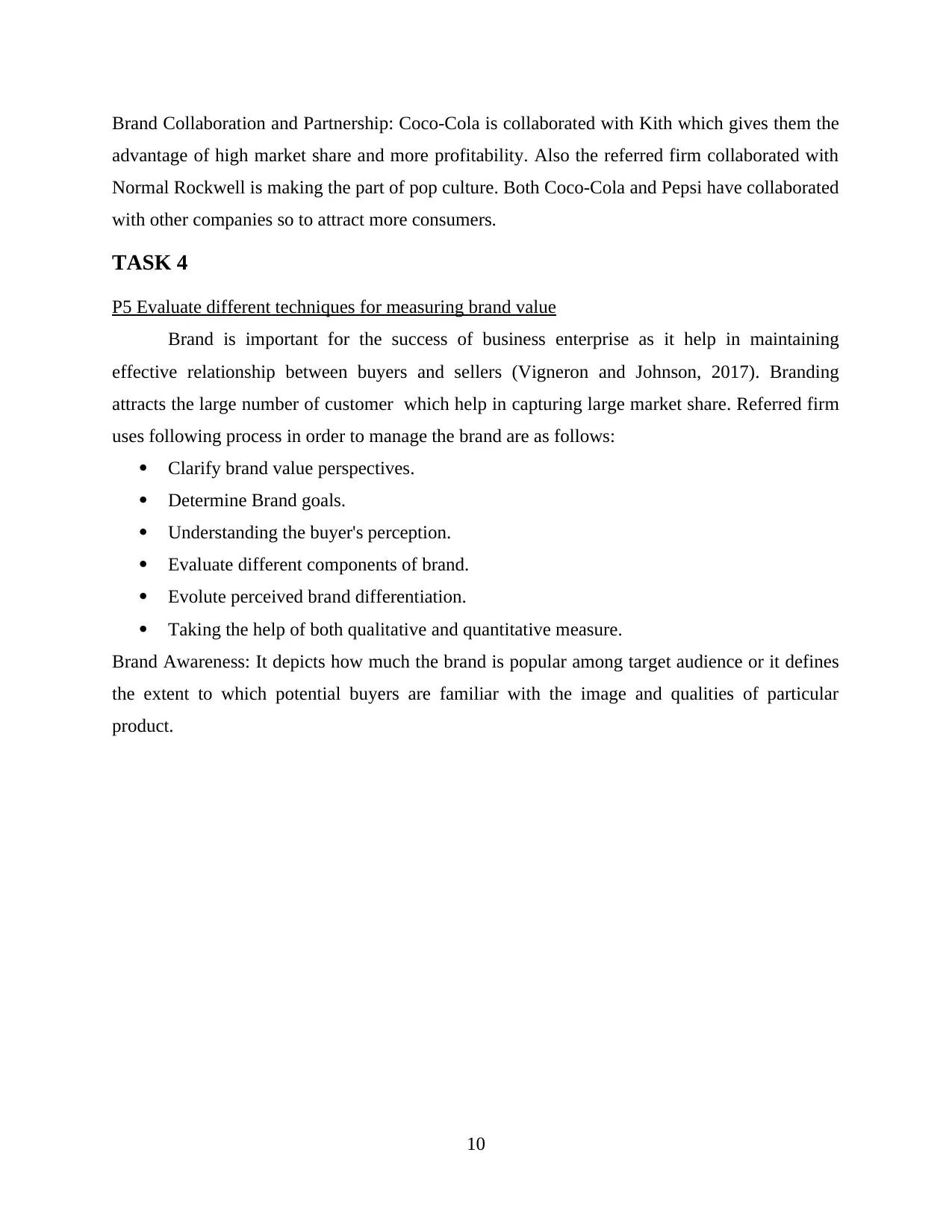
Brand Collaboration and Partnership: Coco-Cola is collaborated with Kith which gives them the
advantage of high market share and more profitability. Also the referred firm collaborated with
Normal Rockwell is making the part of pop culture. Both Coco-Cola and Pepsi have collaborated
with other companies so to attract more consumers.
TASK 4
P5 Evaluate different techniques for measuring brand value
Brand is important for the success of business enterprise as it help in maintaining
effective relationship between buyers and sellers (Vigneron and Johnson, 2017). Branding
attracts the large number of customer which help in capturing large market share. Referred firm
uses following process in order to manage the brand are as follows:
Clarify brand value perspectives.
Determine Brand goals.
Understanding the buyer's perception.
Evaluate different components of brand.
Evolute perceived brand differentiation.
Taking the help of both qualitative and quantitative measure.
Brand Awareness: It depicts how much the brand is popular among target audience or it defines
the extent to which potential buyers are familiar with the image and qualities of particular
product.
10
advantage of high market share and more profitability. Also the referred firm collaborated with
Normal Rockwell is making the part of pop culture. Both Coco-Cola and Pepsi have collaborated
with other companies so to attract more consumers.
TASK 4
P5 Evaluate different techniques for measuring brand value
Brand is important for the success of business enterprise as it help in maintaining
effective relationship between buyers and sellers (Vigneron and Johnson, 2017). Branding
attracts the large number of customer which help in capturing large market share. Referred firm
uses following process in order to manage the brand are as follows:
Clarify brand value perspectives.
Determine Brand goals.
Understanding the buyer's perception.
Evaluate different components of brand.
Evolute perceived brand differentiation.
Taking the help of both qualitative and quantitative measure.
Brand Awareness: It depicts how much the brand is popular among target audience or it defines
the extent to which potential buyers are familiar with the image and qualities of particular
product.
10
⊘ This is a preview!⊘
Do you want full access?
Subscribe today to unlock all pages.

Trusted by 1+ million students worldwide
1 out of 18
Related Documents
Your All-in-One AI-Powered Toolkit for Academic Success.
+13062052269
info@desklib.com
Available 24*7 on WhatsApp / Email
![[object Object]](/_next/static/media/star-bottom.7253800d.svg)
Unlock your academic potential
Copyright © 2020–2025 A2Z Services. All Rights Reserved. Developed and managed by ZUCOL.





